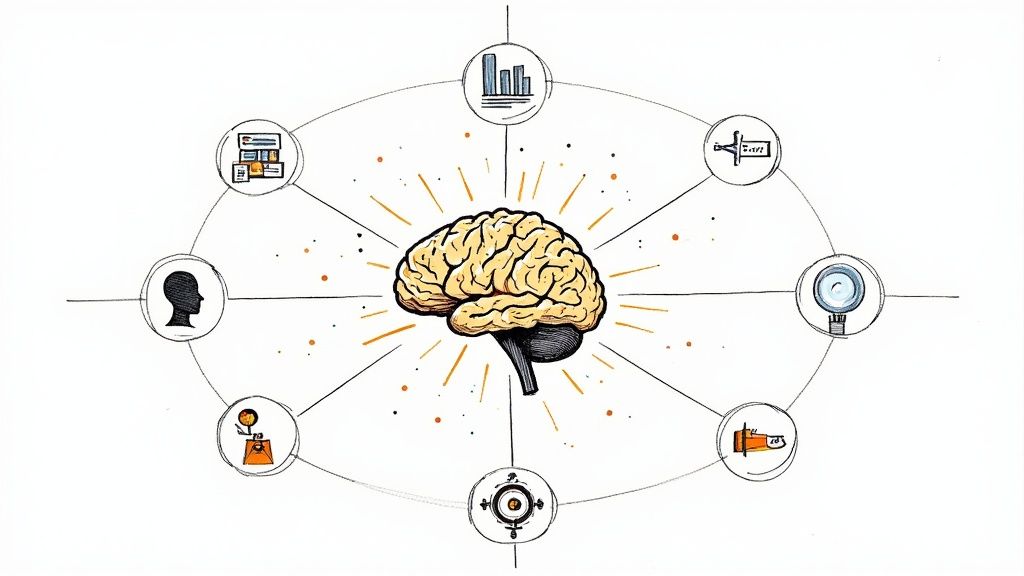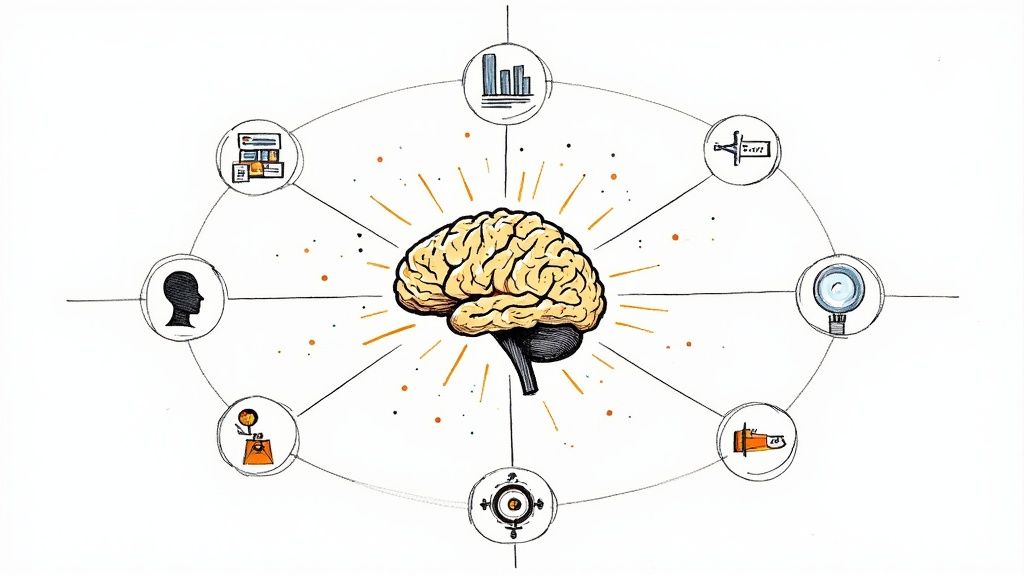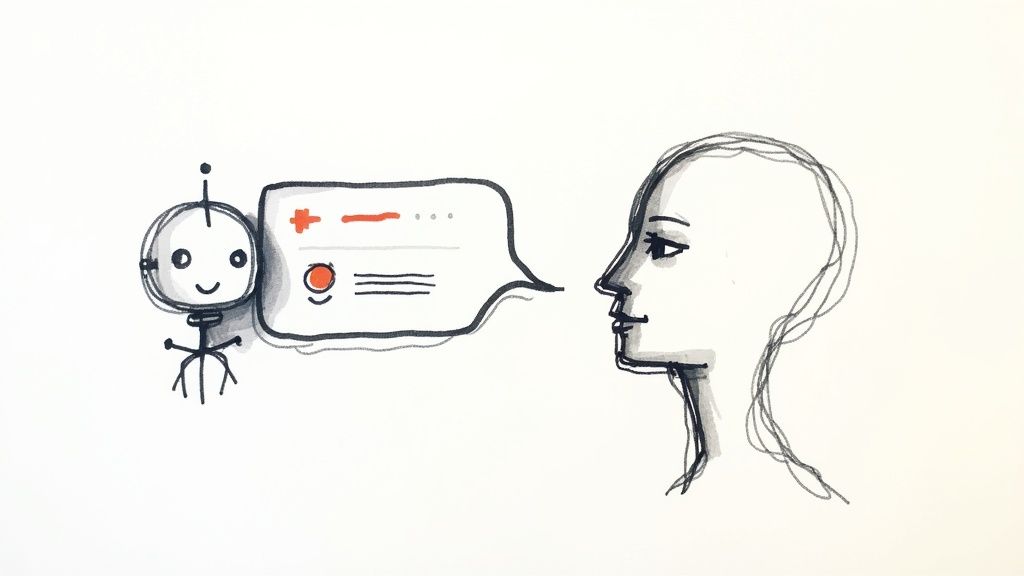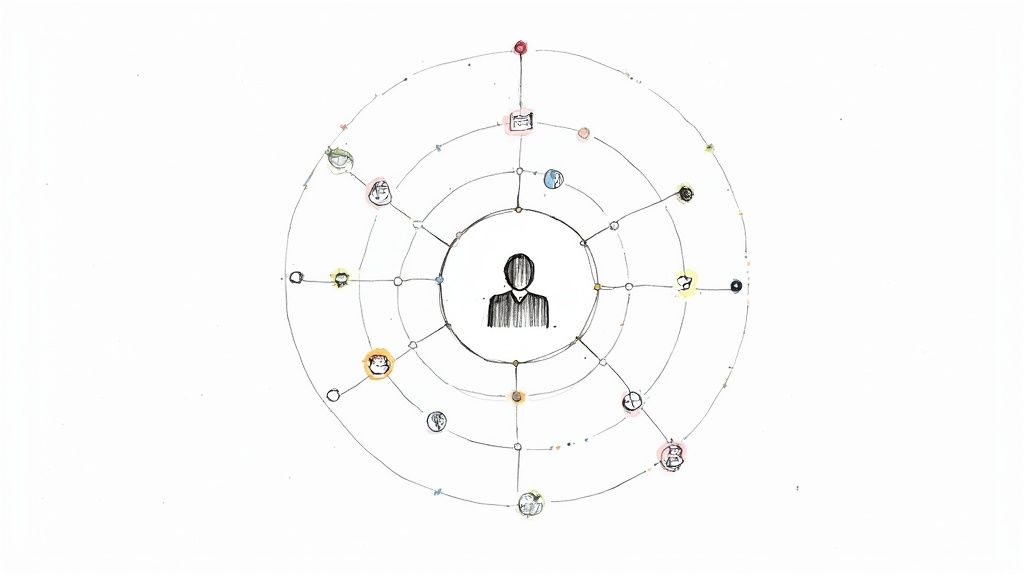
9 AI Driven Marketing Strategies Dominating 2025
Unlock growth with our guide to the top 9 AI driven marketing strategies. Discover actionable tips, real examples, and how to implement them effectively.

In a world of constant digital noise, generic marketing campaigns no longer cut through. The future belongs to brands that can deliver hyper-relevant, personalized experiences at the right moment. This is where Artificial Intelligence steps in, transforming guesswork into predictable science. AI driven marketing strategies are not just a futuristic concept; they are the new standard for achieving measurable growth, maximizing ROI, and building lasting customer relationships. Whether you're a fast-growing business or an established brand, leveraging AI is no longer optional, it's essential for survival and success.
This guide moves beyond theory to provide a clear, actionable blueprint for implementation. We will explore nine powerful ai driven marketing strategies that can give you a decisive competitive edge. You'll learn how to forecast customer behavior with predictive analytics, automate content creation, and deliver hyper-personalized campaigns that resonate deeply with your audience. Each strategy is broken down with practical examples and steps to help you get started immediately, ensuring you can effectively integrate these tools into your marketing operations.
Predictive analytics is one of the most powerful AI-driven marketing strategies available today. It involves using machine learning algorithms to analyze vast amounts of historical data, such as past purchases, browsing behavior, and customer interactions. The goal is to identify patterns and forecast future outcomes, allowing you to anticipate customer needs before they even arise.
This forward-looking approach transforms marketing from a reactive to a proactive function. Instead of just responding to what customers have done, you can create campaigns and offers based on what they are likely to do next. To dive deeper into the foundations of this strategy, you can learn more about data-driven marketing.

Predictive analytics provides a significant competitive edge by enabling hyper-personalization at scale. Companies like Netflix leverage this to power their recommendation engine, which influences over 80% of what users watch. Similarly, Starbucks uses its "Deep Brew" AI to predict which personalized offers will resonate most with individual customers, driving repeat business. This strategy directly impacts your bottom line by improving customer retention and maximizing lifetime value.
AI-powered content generation utilizes natural language processing (NLP) to create, personalize, and optimize marketing materials at scale. These tools can produce everything from blog posts and social media updates to email subject lines and product descriptions. The technology adapts to your brand's voice and audience preferences, dramatically increasing content velocity and efficiency.
By automating the initial drafting process, marketers can focus on high-level strategy and creative refinement. To truly harness AI in content creation, it's essential to begin by understanding AI-generated content and its capabilities.

This strategy is crucial for maintaining a competitive edge in a content-saturated digital world. For example, JPMorgan Chase used Persado's AI to create ad copy that outperformed human copywriters by 450% in click-through rates. Similarly, The Washington Post leverages its Heliograf AI to instantly generate news reports. This technology directly boosts engagement, improves SEO, and accelerates the entire content marketing workflow.
Chatbots and conversational AI are among the most interactive AI-driven marketing strategies, using machine learning to automate human-like conversations. These intelligent systems engage customers 24/7 across websites and messaging apps, providing instant support, qualifying leads, and guiding users through their buying journey.
This technology transforms customer engagement from a one-way broadcast into a two-way dialogue. A significant development in customer interaction is the emergence of conversational marketing as a game-changer, as it focuses on building real-time relationships. To understand its broader applications, you can explore more about using AI in marketing.

Conversational AI provides immediate, scalable support that modern customers expect. For example, Sephora's chatbot offers personalized beauty advice and product recommendations, leading to an 11% increase in conversions. Similarly, Domino's Pizza allows customers to place entire orders through its chatbot on multiple platforms. This strategy drives revenue by reducing friction in the customer journey and improving user satisfaction.
Programmatic advertising is an efficient AI-driven marketing strategy for automating the purchase of digital ad space. It uses AI algorithms to handle the buying, placement, and real-time optimization of ads. This technology sifts through millions of data points to decide the best ad placement, timing, and audience, ensuring your budget is spent on the most impactful impressions.
This automated process replaces manual negotiations with a high-speed, data-informed system, allowing for precise targeting and immediate campaign adjustments. The core benefit is reaching the right user, at the right moment, with the right message, all in a fraction of a second.

Programmatic advertising delivers unparalleled efficiency and scale. For instance, The Economist utilized a programmatic campaign that targeted specific reader personas, resulting in a remarkable 650% ROI. Similarly, the Amanda Foundation increased pet adoptions by 500% by using AI-powered programmatic ads. This strategy provides a direct path to higher engagement and conversion rates by optimizing ad delivery with machine precision.
Hyper-personalization is an advanced AI-driven marketing strategy, moving beyond basic segmentation to deliver individualized customer experiences. It leverages AI to analyze real-time behavioral data, contextual information, and predictive insights. The goal is to tailor content, product recommendations, and communications for each user at every touchpoint.
This approach makes customers feel understood as individuals, not just as part of a demographic. By dynamically adjusting the experience based on a user's immediate actions and predicted needs, you can foster deeper engagement and loyalty. It transforms marketing from a one-to-many broadcast into a series of one-to-one conversations.
Hyper-personalization directly boosts conversion rates and customer lifetime value. Amazon's powerful recommendation engine, a pioneer in this space, is estimated to drive over 35% of its total revenue. Similarly, Nike uses its app to provide personalized training plans and product suggestions based on an individual's activity data, strengthening brand affinity. This level of personalization makes marketing more effective, reducing friction and delighting customers.
AI is transforming email marketing from a batch-and-blast tool into a highly intelligent communication channel. This strategy uses machine learning to analyze recipient behavior and automatically optimize every campaign element. Algorithms can predict the best send times, craft compelling subject lines, personalize content, and segment audiences with a precision that manual efforts cannot match.
By moving beyond simple A/B testing, AI can analyze thousands of data points in real-time to determine what will drive the highest engagement for each individual subscriber. To see how these small optimizations add up to major results, you can learn more about boosting conversion rates.
AI-enhanced email marketing maximizes the ROI of one of the most effective marketing channels. Companies like Phrasee have shown how AI-generated subject lines for Virgin Holidays consistently increased click rates by 2%. Similarly, Sephora’s AI-powered campaigns, which personalize product recommendations based on browsing history and past purchases, achieved a 50% increase in click-through rates, demonstrating a direct link between AI optimization and revenue.
Visual recognition is one of the more futuristic AI-driven marketing strategies that leverages computer vision to interpret and act on visual data. AI models can analyze images and videos to identify objects, logos, places, and even human emotions. This allows marketers to unlock insights from user-generated content, power visual search engines, and create interactive brand experiences.
In an increasingly visual world, this technology helps businesses understand how their brand and products appear in the wild. It transforms passive images into active marketing opportunities, allowing for engagement that goes beyond traditional text-based interactions.
Visual recognition allows brands to connect with customers in a highly intuitive way. For example, Pinterest's Lens feature lets users take a photo of an object to discover where to buy it online, seamlessly bridging the gap between offline inspiration and online purchase. Similarly, beauty brand L'Oreal uses its ModiFace AI for virtual makeup try-on experiences, significantly boosting engagement and conversion rates. This strategy excels at shortening the customer journey and creating immersive interactions.
AI transforms social media by analyzing vast amounts of data in real-time to identify trends, audience sentiment, and engagement opportunities. This is one of the most dynamic AI-driven marketing strategies, moving beyond simple scheduling to offer deep insights. Advanced algorithms can monitor brand mentions, track competitor activity, and even predict which content has the potential to go viral.
By automating the analysis of millions of conversations, AI tools allow marketers to understand public perception and react swiftly. To learn more about how AI integrates into social media tools, you can explore platforms like Sprout Social.
This strategy is crucial for maintaining brand relevance and managing reputation. Wendy's famously uses AI-powered sentiment analysis to identify opportunities for its witty, viral responses. Similarly, Unilever leverages AI social listening to spot emerging micro-trends, which it reports have influenced up to 60% of its product innovations. AI provides the intelligence needed to not only participate in conversations but to lead them.
The rise of voice-activated assistants like Alexa and Google Assistant has changed how consumers search for information. Voice search optimization is an AI-driven marketing strategy that adapts your content for conversational, voice-based queries. It recognizes that people speak differently than they type, using natural language and longer, question-based phrases.
This shift requires marketers to think beyond traditional keywords and optimize for how people actually talk. AI powers the natural language processing (NLP) that understands these voice commands, making it essential to align your content with this technology.
Voice search optimization is crucial for capturing the growing segment of consumers who rely on smart speakers. It enhances brand visibility by securing "position zero" answers in featured snippets, which voice assistants often read aloud. Domino's Pizza has mastered this, allowing customers to order a complete meal through voice commands. Similarly, Tide's "Stain Remover" Alexa skill provides instant, voice-activated cleaning advice. This strategy improves local SEO and creates a convenient customer experience.
The journey through the landscape of AI-driven marketing strategies reveals a clear truth: the future of marketing is about augmenting human ingenuity, not replacing it. We've explored transformative approaches, from using predictive analytics to anticipate customer needs, to deploying AI-powered content generation that scales your messaging. We've seen how conversational AI can offer 24/7 engagement and how hyper-personalization can make every customer feel uniquely valued.
Each strategy serves a common goal: to create marketing that is more efficient, effective, and profoundly more human. AI acts as a powerful lens, allowing you to see patterns, understand intent, and respond to your audience with a level of precision that was once impossible. It’s the engine that powers deeper customer relationships and drives sustainable business growth in a competitive digital world.
Moving from theory to practice is the most critical step. Embracing these concepts doesn't require a complete overhaul of your operations overnight. Instead, a strategic, incremental approach will yield the best results.
Here are actionable steps to begin your journey:
Ultimately, integrating AI is about empowering your team to focus on what they do best: strategy, creativity, and building genuine connections. By automating the data analysis and repetitive work, you free up valuable human capital to innovate and drive your brand forward. Adopting these AI-driven marketing strategies is no longer just an option; it's an essential component for survival and a key driver of competitive advantage.
Ready to turn these powerful concepts into a tangible competitive advantage? BrandBooster.ai specializes in implementing tailored, outcome-driven AI marketing strategies that deliver guaranteed results for fast-growing companies. Visit us at BrandBooster.ai to discover how our blend of advanced technology and expert strategy can unlock your brand's full potential.